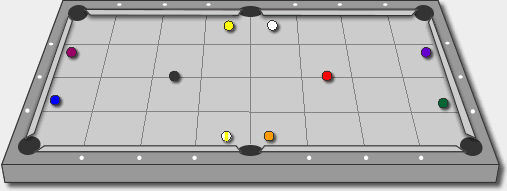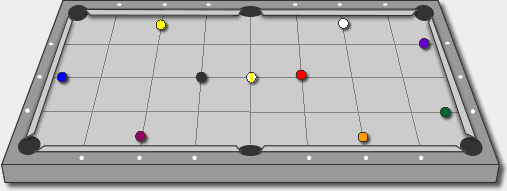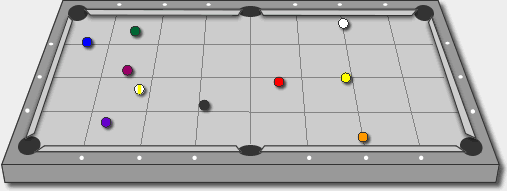connecting the dots
I've come up with three methods of arranging the dots for offensive nine ball practice. They're listed later in this page. In each case, balls 1-9 and the cue ball are arranged randomly among the dots, then I just keep trying until I can run out. When I miss I just put the ball(s) back where they started from and try again, changing my plans as necessary.
To make sure the ball placement is random, just throw the balls onto the table, then put the one ball on the spot nearest to it. Now put the two on the nearest unoccupied spot, and continue through the rest of the balls. The cue ball gets the last unoccupied spot.
Now just run out. Sometimes you'll be kicking at the one - just keep at it. Unless the balls are placed very badly you'll eventually be able to run them out. Once you've done that, throw the balls back on the table and start over. Keep doing this and you'll learn quite a bit about transitions between balls on these spots. Once you get bored with this spot layout just go to another one.
I've found that this is a lot more fun than just shooting drills all the time, and it's a lot more useful than just breaking and shooting racks. You can end up with some very tough transitions. Sometimes you're forced to take two or three hard shots in a row since that's the only way to run out.

This was the first pattern I came up with - and also the toughest of the two preset patterns. No balls are frozen to rails, and all four of the balls near the side pockets go easily. This looks a lot easier than it is. Angles for those side pocket shots become critical, and transitions from one end of the table to another really stress the importance of speed control.
The good news is that all the balls go pretty easily with the proper shape, and a ball on any spot can be made with the cue ball starting at just about any other spot. There are a couple of potential long banks, but they go fairly easily with a little practice. There are also a few potential kicks at balls near the side pockets. These also can be made consistently as long as your stroke is consistent, and you pay attention to what you're doing.

This second pattern of spots is a lot easier than the first. The most important thing here is to get the proper angles on balls along the side rails to get to the next ball. There are a few more potential kicks at the one ball with this layout, so you may want to swap the cue ball with another ball to help you get started.

This third example is not a set pattern, it's just an example of a completely random arrangement. These arrangements can be easy or tough, but since the balls are placed on different spots after each runout you can still learn an awful lot. Again, you may want to consider the cue ball, one ball, and two ball placement, and rearrange them to make the runout more possible.
For even more fun, I'll throw just five balls on the table, use the dots as described above, then keep working that layout until I bank all five in without missing.
David S. Siltz

This work is licensed under a Creative Commons License.